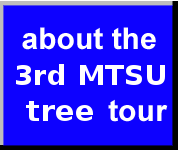
|

|

|

|
An individual instance of Fraxinus pennsylvanica (green ash)
Permanent unique identifier for this particular organism:
http://bioimages.vanderbilt.edu/mtsu/36
Notes:
General: Green ash is a native spreading, round topped tree which grows to a height of 70 feet or more. The deciduous leaves are pinnately compound, 8 to 12 inches long, with 5 to 9 leaflets. The leaflets are oblong, lustrous green on both sides or somewhat paler beneath. The twigs are pale gray along with brown bark. The fruit (samara), usually containing one seed, is light colored, 1 to 2 inches long and ¼ to 1/3 inch wide with a wing.
Habitat
Green ash is found in areas with 15 to 60 inches of yearly precipitation. It is found growing naturally in bottomlands subject to frequent flooding or overflow. Green ash is moderately tolerant to shade. Some woody species associated with green ash include box elder (Acer negundo), red maple (A. rubrum), pecan (Carya illinoinensis), eastern cottonwood (Populus deltoides), black willow (Salix nigra), and American elm (Ulmus americana).
Uses
Livestock: Green ash stems are browsed by livestock. Cattle utilize green ash habitats for shade, water, protection, and shelter during calving season.
Wildlife: Green ash seeds, stems, and foliage provide cover and food for several small animal species including rabbit. Both game and nongame bird species use this habitat for food, nesting sites and roosts. Black birds, finches, grosbeaks, and cardinal feed on ash fruits. In a study by Hopkins (1984), the Coopers hawk and mountain bluebird nested only in green ash woods.
Residential: Green ash is popular as a shade tree in residential areas because of its good form and adaptability to a wide range of sites.
Windbreak: Green ash is used frequently in windbreaks and shelterbelt plantings.
Pests and Potential Problems
The emerald ash borer (Agrilus planipennis) was accidentally introduced from Asia in Michigan approximately fifteen years ago. Only attacking ash trees, the beetles can kill an ash tree within three years (Tennessee Department of Agriculture, 2016). It has spread through many states, including Tennessee, and is responsible for the loss of millions of ash (Fraxinus sp.) trees. In Tennessee, 47 counties have been quarantined in an effort to reduce the spread of the emerald ash borer (TDA, 2016).
References
Brakie, M., (2013). Plant guide for green ash (fraxinus pennsylvanica). Retrieved from http://plants.usda.gov/java/factSheet
Hopkins, R.B. (1984). Avian species associated with prairie woodland types. In Noble, D.L. & R.P. Winokur (Eds.), Wooded draws: Characteristics and values for the northern great plains: Proceedings of the symposium (pp. 27-35). Rapid City, SD: South Dakota School of Mines and Technology, Biology Department.
Tennessee Department of Agriculture (2016). Emerald ash borer (HTML). Retrieved from http://www.tn.gov/agriculture/topic/ag-businesses-eab

|

|
|
Load database and switch to thumbnail view
Use this stable URL to link to this page:
http://bioimages.vanderbilt.edu/mtsu/36.htm
This particular organism is believed to have managed means of establishment.
This organismal entity has the scope: multicellular organism.
Identifications:
Fraxinus pennsylvanica
Marshall
sec. Tennessee Flora 2014
common name: green ash
family: Oleaceae
Identified 2016-03-13 by Patrick Phoebus
Location:
Visitor's Circle, Cope Administration Building, Rutherford County, Tennessee, US
Click on these geocoordinates to load a map showing the location: 35.8459°, -86.3697°
Coordinate uncertainty about: 10 m.
Altitude: 185 m.
Location calculated as average of its images' coordinates.
Occurrences were recorded for this particular organism on the following dates:
2016-03-13
2016-04-14
2016-04-27
The following images document this particular organism.
Click on a thumbnail to view the image and its metadata. Load database and enable navigation by taxon and organism.